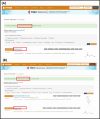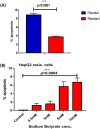Bacterial metabolite butyrate in modulating sorafenib-targeted microRNAs to curtail its resistance in hepatocellular carcinoma
- PMID: 36583742
- PMCID: PMC11798150
- DOI: 10.1007/s00432-022-04544-7
Bacterial metabolite butyrate in modulating sorafenib-targeted microRNAs to curtail its resistance in hepatocellular carcinoma
Abstract
Background and aim: The host dietary fibre is fermented into short-chain fatty acids (SCFA) by intestinal microbiota as bacterial metabolites like propionate, acetate and butyrate. Among these metabolites, the role of butyrate is well documented to provide energy to intestinal epithelial cells. Also, butyrate has anti-inflammatory and anti-tumour properties and decrease in its level by unbalanced diet can develops cancer. Lately, some research has suggested that sodium butyrate as an inhibitor of histone deacetylase (HDAC) may have anticancer potential for hepatocellular carcinoma (HCC), the most common type of liver cancer. Since, HCC is asymptomatic it is usually diagnosed at its advanced stage. Sorafenib with antiproliferative and antiangiogenic effects is the first line of treatment in advanced HCC. However, prolonged drug treatment to HCC patients develops adaptive resistance towards the sorafenib. Sorafenib resistance can also be enhanced by differentially expressed microRNAs. However, the significance of butyrate in HCC sorafenib resistance and its association with sorafenib-targeted microRNAs is yet to be unfurled. Here, an attempt has been made to explore the role of bacterial metabolite butyrate on sorafenib resistant HCC as well as on sorafenib-targeted microRNAs (miR-7641 and miR-199) to curtail sorafenib resistance in HCC.
Methods: Initially, in-silico analysis was performed using Human Metabolome Database (HMDB) so to identify specific butyrate producing faecal bacteria. Then, their specific 16s rRNA expression was compared between HCC patients and healthy individuals using qRT-PCR. Additionally, the cell viability (MTT) and apoptosis assays were performed in both parental and sorafenib resistant HepG2 cells to evaluate the role of sodium butyrate in sorafenib resistant HCC. Moreover, the association of sodium butyrate with sorafenib-targeted miR-7641 and miR-199 was also assessed using real time PCR, cell viability, cell apoptosis and transfection assays.
Results: In silico analysis demonstrated Roseburia cecical, Roseburia intestinalis, Eubacterium rectal, Faecalibacterium prausnitzii as specific butyrate producing faecal bacteria and their 16s rRNA expression was downregulated in HCC patients. In vitro study revealed the presence of sodium butyrate also decreased the cell viability as well as enhanced cell apoptosis of both parental and resistant HepG2 cells. Interestingly, sodium butyrate also decreased the expression of both sorafenib-targeted miR-7641 and miR-199. Further, combination of both sodium butyrate and antimiR-7641 or antimiR-199 also increased apoptosis and decreased viability of resistant cells.
Conclusion: This is first study to unravel the association of butyrate producing bacteria with HCC patients and the significance of bacterial metabolite butyrate as anti-tumour in sorafenib resistant hepatocellular carcinoma. The study also demonstrated the plausible new aspects of bacterial metabolite butyrate association with sorafenib-targeted miRNAs (miR-7641 and miR-199). Hence, the study highlighted the therapeutic potential of bacterial metabolite butyrate that might improve the clinical management of hepatocellular carcinoma.
Keywords: Bacterial metabolite butyrate; Carcinoma; Hepatocellular; MicroRNAs; Resistance; Sorafenib.
© 2022. The Author(s), under exclusive licence to Springer-Verlag GmbH Germany, part of Springer Nature.
Conflict of interest statement
The authors declare no competing interests.
Figures
















Similar articles
-
PIMREG modulation of PI3K/Akt pathway enhances sorafenib resistance in Huh7 cells.Arab J Gastroenterol. 2025 Aug;26(3):241-249. doi: 10.1016/j.ajg.2025.05.002. Epub 2025 Jun 28. Arab J Gastroenterol. 2025. PMID: 40582902
-
The Black Book of Psychotropic Dosing and Monitoring.Psychopharmacol Bull. 2024 Jul 8;54(3):8-59. Psychopharmacol Bull. 2024. PMID: 38993656 Free PMC article. Review.
-
SMYD2 epigenetically activates BMP4/SMAD1/5/8/ID3 axis to enhance cancer stem cell properties and drive sorafenib resistance in hepatocellular carcinoma.Neoplasia. 2025 Sep;67:101203. doi: 10.1016/j.neo.2025.101203. Epub 2025 Jul 1. Neoplasia. 2025. PMID: 40609277 Free PMC article.
-
In vivo CRISPR screening identifies POU3F3 as a novel regulator of ferroptosis resistance in hepatocellular carcinoma via retinoic acid signaling.Cell Commun Signal. 2025 Jul 10;23(1):329. doi: 10.1186/s12964-025-02285-x. Cell Commun Signal. 2025. PMID: 40634958 Free PMC article.
-
Insights into Sorafenib resistance in hepatocellular carcinoma: Mechanisms and therapeutic aspects.Crit Rev Oncol Hematol. 2025 Aug;212:104765. doi: 10.1016/j.critrevonc.2025.104765. Epub 2025 May 17. Crit Rev Oncol Hematol. 2025. PMID: 40389183 Review.
Cited by
-
Roles of the gut microbiota in hepatocellular carcinoma: from the gut dysbiosis to the intratumoral microbiota.Cell Death Discov. 2025 Apr 4;11(1):140. doi: 10.1038/s41420-025-02413-z. Cell Death Discov. 2025. PMID: 40185720 Free PMC article. Review.
-
Gut microbiota-derived short-chain fatty acids regulate gastrointestinal tumor immunity: a novel therapeutic strategy?Front Immunol. 2023 Apr 14;14:1158200. doi: 10.3389/fimmu.2023.1158200. eCollection 2023. Front Immunol. 2023. PMID: 37122756 Free PMC article. Review.
-
Microbiota, mitochondria, and epigenetics in health and disease: converging pathways to solve the puzzle.Pflugers Arch. 2025 May;477(5):635-655. doi: 10.1007/s00424-025-03072-w. Epub 2025 Mar 20. Pflugers Arch. 2025. PMID: 40111427 Review.
-
The Role of the Gut-Biliary-Liver Axis in Primary Hepatobiliary Liver Cancers: From Molecular Insights to Clinical Applications.J Pers Med. 2025 Mar 24;15(4):124. doi: 10.3390/jpm15040124. J Pers Med. 2025. PMID: 40278303 Free PMC article. Review.
-
Analysis of Carcinogenic Involvement of MicroRNA Pattern in Peripheral Non-Cancerous Tissues and Chronic Viral Liver Injury.Int J Mol Sci. 2024 Jul 18;25(14):7858. doi: 10.3390/ijms25147858. Int J Mol Sci. 2024. PMID: 39063098 Free PMC article.
References
-
- Bartel DP (2004) MicroRNAs: genomics, biogenesis, mechanism, and function. Cell 116(2):281–297 - PubMed
-
- Bray F, Ferlay J, Soerjomataram I, Siegel RL, Torre LA, Jemal A (2018) Global cancer statistics 2018: GLOBOCAN estimates of incidence and mortality worldwide for 36 cancers in 185 countries. CA Cancer J Clin 68(6):394–424 - PubMed
MeSH terms
Substances
Grants and funding
LinkOut - more resources
Full Text Sources
Medical

